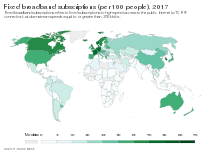
In telecommunications, broadband or high speed is the wide-bandwidth data transmission that exploits signals at a wide spread of frequencies or several different simultaneous frequencies, and is used in fast Internet access. The transmission medium can be coaxial cable, optical fiber, wireless Internet (radio), twisted pair cable, or satellite.
Originally used to mean 'using a wide-spread frequency' and for services that were analog at the lowest level, nowadays in the context of Internet access, 'broadband' is often used to mean any high-speed Internet access that is seemingly always 'on' and is faster than dial-up access over traditional analog or ISDN PSTN services.[1]
The ideal telecommunication network has the following characteristics: broadband, multi-media, multi-point, multi-rate and economical implementation for a diversity of services (multi-services).[2][3] The Broadband Integrated Services Digital Network (B-ISDN) was planned to provide these characteristics. Asynchronous Transfer Mode (ATM) was promoted as a target technology for meeting these requirements.[3]
- ^ "Types of Broadband Connections; Federal Communications Commission". Fcc.gov. 2014-06-23. Archived from the original on 2022-06-05. Retrieved 2022-06-05.
- ^ Lu, Fang. "ATM Congestion Control". Archived from the original on 10 February 2005. Retrieved 1 March 2005.
- ^ a b Saito, H. (1993). Teletraffic Technologies in ATM Networks. Artech House. ISBN 0-89006-622-1.